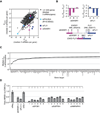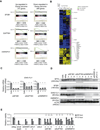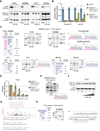Functional Genomic Screening Reveals Splicing of the EWS-FLI1 Fusion Transcript as a Vulnerability in Ewing Sarcoma
- PMID: 26776507
- PMCID: PMC4755295
- DOI: 10.1016/j.celrep.2015.12.063
Functional Genomic Screening Reveals Splicing of the EWS-FLI1 Fusion Transcript as a Vulnerability in Ewing Sarcoma
Abstract
Ewing sarcoma cells depend on the EWS-FLI1 fusion transcription factor for cell survival. Using an assay of EWS-FLI1 activity and genome-wide RNAi screening, we have identified proteins required for the processing of the EWS-FLI1 pre-mRNA. We show that Ewing sarcoma cells harboring a genomic breakpoint that retains exon 8 of EWSR1 require the RNA-binding protein HNRNPH1 to express in-frame EWS-FLI1. We also demonstrate the sensitivity of EWS-FLI1 fusion transcripts to the loss of function of the U2 snRNP component, SF3B1. Disrupted splicing of the EWS-FLI1 transcript alters EWS-FLI1 protein expression and EWS-FLI1-driven expression. Our results show that the processing of the EWS-FLI1 fusion RNA is a potentially targetable vulnerability in Ewing sarcoma cells.
Copyright © 2016 The Authors. Published by Elsevier Inc. All rights reserved.
Figures







References
-
- Bonnal S, Vigevani L, Valcarcel J. The spliceosome as a target of novel antitumour drugs. Nat Rev Drug Discov. 2012;11:847–859. - PubMed
Publication types
MeSH terms
Substances
Grants and funding
LinkOut - more resources
Full Text Sources
Other Literature Sources
Molecular Biology Databases

